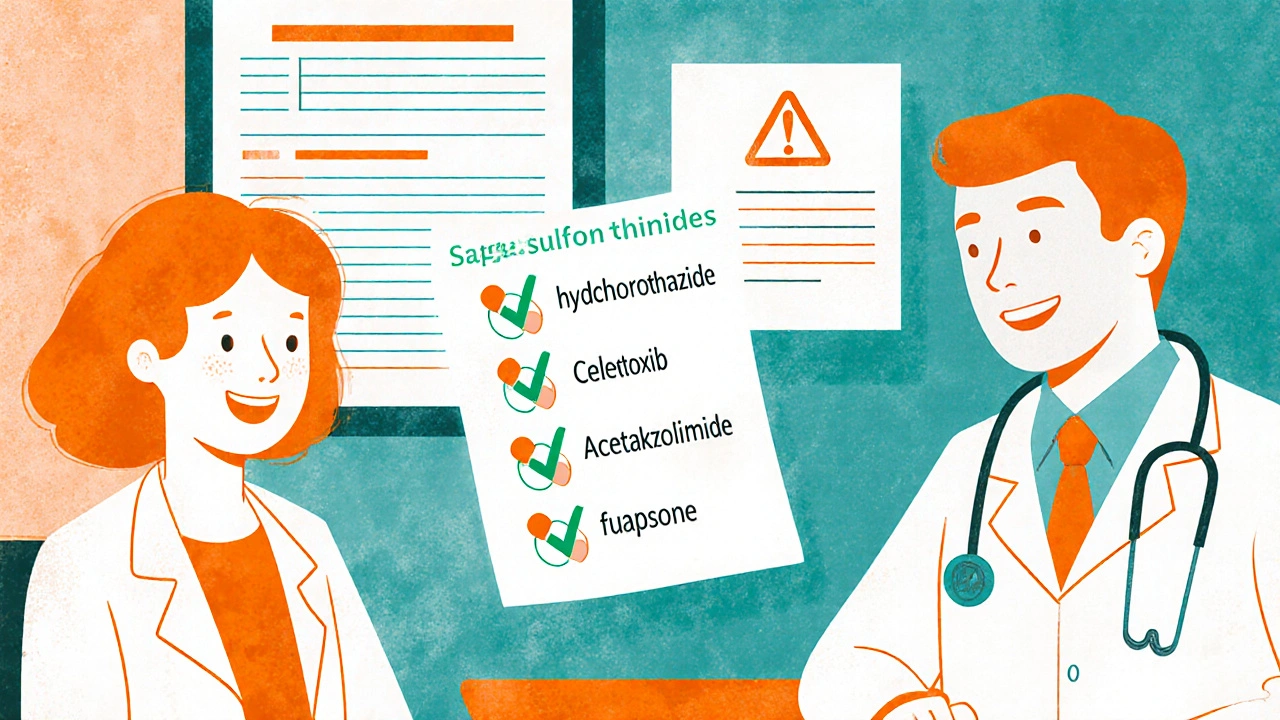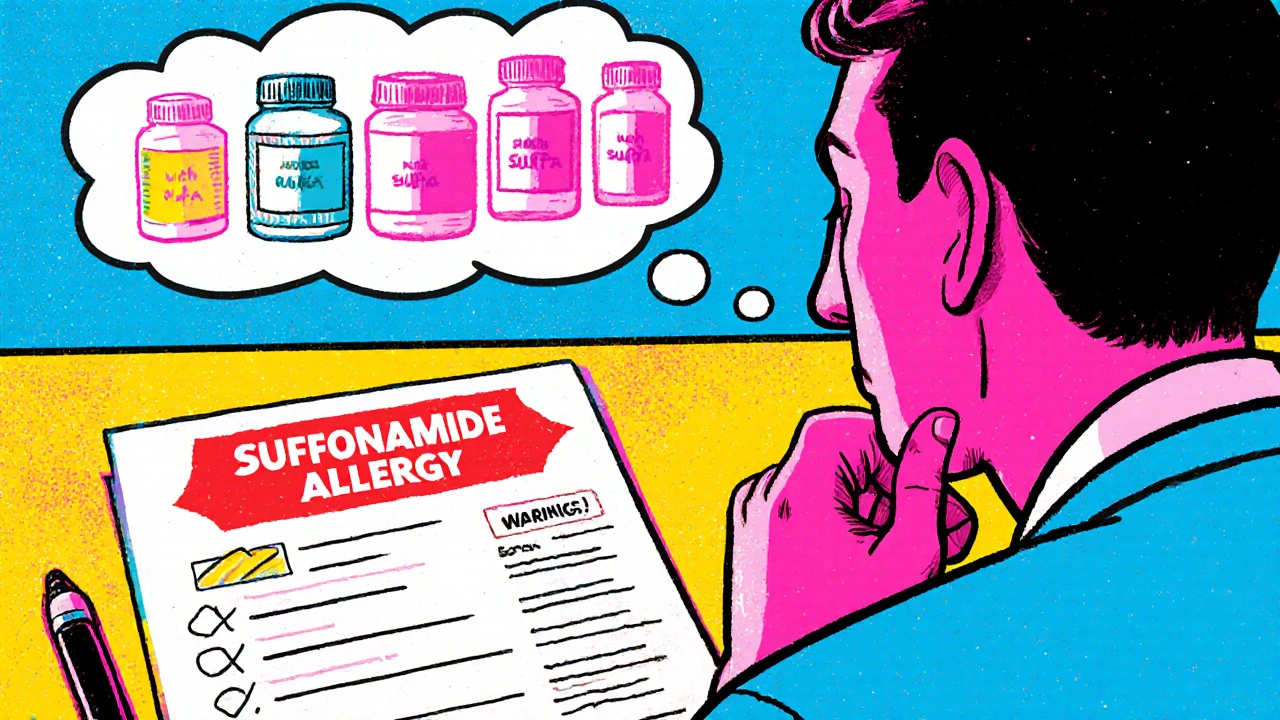Sulfonamide Cross-Reactivity Checker
Is this sulfonamide drug safe for you?
Based on current medical evidence, most non-antimicrobial sulfonamides are safe for patients with a documented sulfonamide-antibiotic allergy. This tool helps determine which drugs can be used safely.
When a patient’s chart reads Sulfonamide allergy - a label that often looks like a warning sign - most clinicians instinctively avoid every drug that contains the word “sulfa.” That blanket avoidance can push people onto broader‑spectrum antibiotics, raise costs, and even increase resistance. Understanding what really reacts with the immune system, and what doesn’t, lets doctors keep patients safe while preserving treatment options.
What is a sulfonamide allergy?
In the strictest sense, a sulfonamide allergy is an IgE‑mediated or T‑cell‑mediated hypersensitivity to the antimicrobial class of sulfonamides - drugs like sulfamethoxazole‑trimethoprim, sulfadiazine, and sulfasalazine. The 2023 AAAAI practice parameter estimates that true immune‑mediated reactions affect only 0.3‑0.5 % of the population, even though up to 12 % of people self‑report a “sulfa allergy.” Most of those reports stem from side‑effects (nausea, mild rash) or from unrelated conditions mis‑attributed to the drug.
Why cross‑reactivity isn’t automatic
All sulfonamides share the SO₂NH₂ core, but the allergy‑triggering piece lives at the N4 position - an aryl‑amine group - and a substituted heterocycle at N1. Antimicrobial sulfonamides contain both, which lets them form reactive metabolites that bind to proteins and create neo‑antigens. Non‑antimicrobial sulfonamides such as celecoxib, hydrochlorothiazide, and acetazolamide lack the aryl‑amine, so their metabolic pathways never generate the same reactive intermediates. This structural distinction is why the negative predictive value of a documented sulfonamide‑antibiotic allergy for non‑antibiotic sulfonamides sits around 96‑98 %.
Antimicrobial vs. non‑antimicrobial sulfonamides - a side‑by‑side look
| Feature | Antimicrobial sulfonamides | Non‑antimicrobial sulfonamides |
|---|---|---|
| Core sulfonamide group | SO₂NH₂ present (yes) | SO₂NH₂ present (yes) |
| N4 aryl‑amine | Present - primary antigenic determinant | Absent - markedly reduces immunogenicity |
| N1 heterocycle | Substituted nitrogen‑containing ring (essential for activity) | Varies - many have simple methyl or aromatic groups |
| Typical examples | Sulfamethoxazole, sulfadiazine, sulfasalazine | Celecoxib, hydrochlorothiazide, furosemide, acetazolamide |
| Cross‑reactivity risk (documented antibiotic allergy) | 100 % (by definition) | ~1‑2 % (statistically insignificant) |
| Common clinical uses | UTI, PCP prophylaxis, certain dermatologic infections | Glaucoma (acetazolamide), hypertension (hydrochlorothiazide), pain (celecoxib) |
Which non‑antimicrobial sulfonamides are truly safe?
For most patients with a documented sulfonamide‑antibiotic allergy, the following drugs can be prescribed without a formal allergy work‑up:
- Hydrochlorothiazide - used for hypertension and edema; multiple studies show a 1.1 % reaction rate, indistinguishable from the general population.
- Celecoxib - a COX‑2 selective NSAID; large registry data report no excess rash or anaphylaxis when used after a low‑risk sulfa label.
- Acetazolamide - for glaucoma or altitude sickness; scarce reports of hypersensitivity in sulfa‑allergic patients.
- Furosemide - loop diuretic; real‑world experience suggests negligible cross‑reactivity.
The one notable exception is dapsone. Because it retains the N4 aryl‑amine, studies find a 13 % reaction rate among sulfonamide‑antibiotic-allergic individuals. If dapsone is truly needed (e.g., for PCP prophylaxis in an HIV patient), an allergist‑guided graded challenge is recommended.
How to evaluate a reported sulfonamide allergy
The AAAAI recommends a three‑step algorithm:
- History stratification - Determine the timing, severity, and morphology of the reaction. A rash that appeared after five days with no systemic symptoms is low‑risk.
- Skin testing (if available) - Some centers use sulfamethoxazole‑albumin conjugates. A negative test has a >94 % predictive value for tolerance.
- Direct oral challenge - For low‑risk cases, give a single therapeutic dose of the non‑antibiotic sulfonamide under observation. Over 99 % of challenges are uneventful.
High‑risk histories (e.g., Stevens‑Johnson syndrome, anaphylaxis) merit referral to an allergy specialist for graded dosing and possibly in‑patient monitoring.
Documentation matters - “sulfa allergy” is too vague
Electronic health records often store a generic flag “sulfa allergy.” A 2021 JACI practice study showed that when clinicians replace that with a detailed note - “maculopapular rash on day 5 of sulfamethoxazole‑trimethoprim, no systemic involvement” - inappropriate avoidance drops by 63 %.
Best‑practice documentation checklist:
- Drug name (including brand and generic)
- Exact reaction (rash, hives, fever, organ involvement)
- Onset timing relative to the first dose
- Management needed (antihistamines, steroids, hospitalization)
Clear notes allow decision‑support tools (e.g., Epic’s sulfonamide allergy algorithm) to suggest safe alternatives automatically.
Impact of mislabeling - costs, resistance, and patient outcomes
When clinicians avoid sulfonamide antibiotics because of an unverified label, alternative agents like fluoroquinolones or carbapenems are prescribed more often. A 2021 analysis found a 2.4‑fold increase in fluoroquinolone use, which carries black‑box warnings for tendon rupture and aortic aneurysm. Financially, the U.S. health system spends an extra $1.2 billion each year on broader‑spectrum antibiotics and longer hospital stays attributable to mislabelled sulfa allergies.
Beyond dollars, the public‑health toll shows up in resistance patterns. CDC data link inappropriate drug selection from false sulfa labels to an 8.3 % rise in resistant E. coli and a 12.7 % rise in resistant S. aureus.

Future directions - de‑labeling initiatives and new diagnostics
The 2023 AAAAI/IDSA Sulfonamide Allergy De‑labeling Initiative introduced a standardized risk‑stratification tool (the SULF‑RISK score). In validation cohorts, the score achieved 92 % sensitivity and 88 % specificity for true IgE‑mediated sulfonamide allergy. Hospitals that adopted the tool reduced inappropriate avoidance by 45 % within six months.
On the diagnostic front, a phase‑II trial of a sulfamethoxazole‑specific IgE assay showed an 89.7 % positive predictive value, suggesting that component‑resolved testing could soon replace cumbersome oral challenges for low‑risk patients.
By 2025, analysts predict that three‑quarters of major health systems will embed automated sulfonamide allergy assessments into their EHRs, potentially saving $360 million annually and cutting unnecessary broad‑spectrum antibiotic use by 30 %.
Practical takeaways for clinicians and patients
- Don’t assume blanket cross‑reactivity. Most non‑antibiotic sulfonamides are safe for patients with a true sulfonamide‑antibiotic allergy.
- Clarify the reaction. Ask when it happened, what the skin looked like, and whether there were systemic signs.
- Consider a direct challenge. For low‑risk histories, a supervised oral dose can clear the label in under an hour of observation.
- Document precisely. Replace “sulfa allergy” with a detailed reaction note to help decision‑support tools.
- Educate patients. Explain that sulfur, sulfates, and sulfites are unrelated chemicals - they can still eat foods with those ingredients.
Frequently Asked Questions
Can I take acetazolamide if I have a sulfonamide‑antibiotic allergy?
Yes. Acetazolamide lacks the N4 aryl‑amine that triggers most sulfonamide‑antibiotic reactions. Large case series show no increased risk compared with the general population.
Is dapsone safe for someone with a sulfa allergy?
Only after formal allergy evaluation. Dapsone retains the aryl‑amine group, and studies report a 13 % reaction rate in sulfonamide‑antibiotic-allergic patients. A graded challenge in an allergy clinic is advised.
Do sulfates or sulfites in food affect me?
No. Sulfates and sulfites are chemically distinct from sulfonamide drugs. They do not contain the SO₂NH₂ core and are not linked to drug‑related hypersensitivity.
How reliable is a skin test for sulfonamide allergy?
When performed with validated sulfamethoxazole conjugates, a negative test predicts tolerance in about 94-95 % of cases. Positive results, however, still require clinical correlation.
Should I keep my “sulfa allergy” label in my medical record?
Only if the reaction meets criteria for a true IgE‑mediated or severe T‑cell response. Otherwise, a detailed note or removal after de‑labeling prevents unnecessary drug avoidance.
Bottom line: a documented sulfonamide‑antibiotic allergy rarely means you have to avoid every drug with the word “sulfa.” By teasing out the chemistry, asking the right questions, and using modern testing, clinicians can keep patients on the most appropriate therapy while sparing the health system from needless cost and resistance.

Joy Dua
October 26, 2025 AT 17:35
In the realm of sulfonamide hypersensitivity the chemistry tells a nuanced story. The immune system recognises the N4 aryl‑amine rather than the shared SO₂NH₂ backbone. Consequently non‑antibiotic sulfonamides such as hydrochlorothiazide and celecoxib sit on the periphery of true allergy. Practitioners who overlook this distinction may weaponise a vague label into unnecessary broad‑spectrum prescribing.
Holly Kress
November 5, 2025 AT 14:35
That explanation helps clinicians differentiate between the drug classes without over‑reacting. It also gives patients confidence that not every “sulfa” tag is a death sentence. By documenting the exact reaction clinicians can make smarter choices.
Chris L
November 15, 2025 AT 11:35
I echo this optimism and encourage teams to use the SULF‑RISK score when evaluating patients. A low‑risk history paired with a supervised challenge can clear the label quickly. This approach safeguards both patient safety and antimicrobial stewardship.
Tony Stolfa
November 25, 2025 AT 08:35
Wow you really think a fancy table solves everything, huh?
laura balfour
December 5, 2025 AT 05:35
Oh dear, the drama of a label turning into a medical drama is just *chef’s kiss*-so many doctors running scared! I’ve seen a sulfa flag turn a simple hypertension prescription into a costly saga, & it’s a proper mess. The chemistry is clear, but the fear is all over the place, innit?
Abbey Travis
December 15, 2025 AT 02:35
Totally agree that we need to be clear in the records. A quick note about the rash timing can save a lot of hassle later. Plus, patients feel heard when we explain why celecoxib is actually safe for them. Let’s keep the language simple and the guidance solid.
ahmed ali
December 24, 2025 AT 23:35
First of all, let me point out that the whole narrative about sulfonamide cross‑reactivity is a bit over‑simplified and, frankly, a little outdated. While the literature does highlight the N4 aryl‑amine as the chief antigenic culprit, the metabolic pathways are far more tangled than a simple binary split. For instance, even some non‑antibiotic sulfonamides can generate reactive metabolites under certain hepatic enzyme polymorphisms, and that nuance is glossed over in most summary tables. Moreover, the cited “1‑2 %” cross‑reactivity figure often stems from retrospective chart reviews that do not control for concomitant drug exposures, making the risk appear smaller than it might truly be. In practice, I have encountered patients who tolerated hydrochlorothiazide but then experienced a delayed maculopapular rash after starting furosemide, suggesting that the N1 heterocycle can also influence immunogenicity. To add another layer, the immune response can be mediated by IgG subclasses in some cases, which are not captured by standard IgE skin testing, yet they can still precipitate severe reactions. The SULF‑RISK score, while a step forward, does not incorporate pharmacogenomic data that could predict who is a metaboliser versus a poor metaboliser of sulfonamide moieties, and that omission limits its predictive power. Also, let’s not forget the impact of concomitant viral infections which can amplify drug hypersensitivity, a factor that most guidelines barely mention. In terms of stewardship, indiscriminately labeling a patient as sulfa‑allergic often drives the prescription of fluoroquinolones, but the downstream consequences include tendon rupture and even aortic aneurysm, risks that far outweigh a theoretical sulfonamide reaction. From a health‑economics perspective, the $1.2 billion extra cost estimate is based on average drug prices and does not adjust for regional formularies, so the real figure could be higher in certain health systems. Lastly, while component‑resolved testing shows promise, the assay’s sensitivity varies greatly depending on the laboratory’s calibration, meaning a negative result is not an absolute green light. All these points suggest that we should adopt a more nuanced, case‑by‑case approach rather than relying on blanket statements. In short, yes, many non‑antibiotic sulfonamides are generally safe, but the devil is in the details, and clinicians need to stay vigilant and personalized in their assessment. Therefore, before dismissing a sulfa label outright, I recommend a thorough review of the patient’s medication timeline and any prior desensitisation attempts. Furthermore, shared decision‑making with the patient about the risks and benefits of alternative agents fosters trust and better outcomes. In the end, personalized medicine triumphs over one‑size‑fits‑all guidelines.